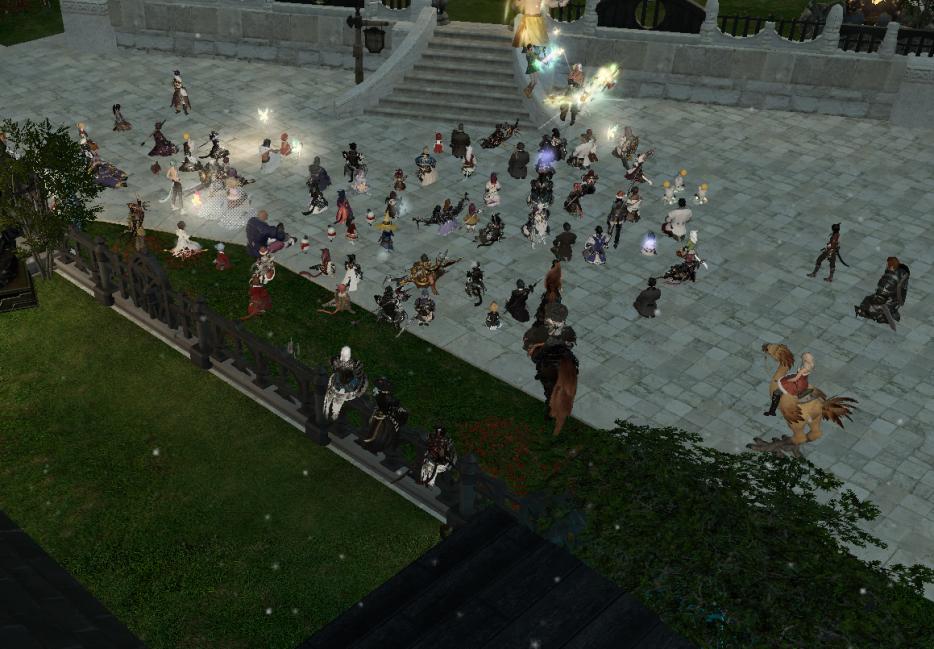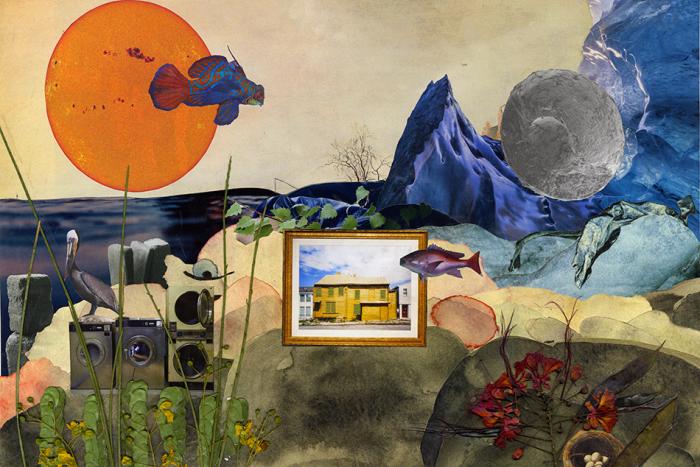On December 21st, 2014, hundreds of Final Fantasy XIV players gathered online within the game to mourn the death of one of their own. He went by the username Codex Vahlda, a twenty-nine-year-old who had suffered complications from renal failure. At the time, Vahlda was brain dead; his family was keeping him alive—they wanted a chance to say goodbye.
The Final Fantasy XIV community reacted to the news swiftly. Across multiple servers within the MMORPG (Massively Multiplayer Online Role Playing Game), players, through elfish avatars equipped with swords, bows, and spears, held virtual funerals for Vahlda. In one server, a group of gamers—first one, then a dozen, then over eighty—knelt in front of a large house in his honor. In another, players on a beach created a virtual light show, gathering together to spell out “CODEX.” The online funeral was live-streamed in Vahlda’s hospital room for his family to see. As the events unfolded, news spread to various message boards, and hundreds of other players posted condolences.
Later that day, reflecting on the mass funeral, Kotaku writer Mike Fahey described the closeness felt by MMORPG players: “I know that whoever Codex Vahlda was, every single person in these images—in his final moments—cared for him like they were his dear friends. When a group of people is deeply invested in a virtual world... there's a bond there that crosses any and all real-world lines.”
But for those who form deep connections online, collective grieving isn’t always an option. Caitlin Riddle, an artist and mental health advocate, met her best friend Shanice in early February 2015 through a mental health awareness Facebook page that Caitlin administrated. At the time, they were both fourteen. Shanice messaged Caitlin to say she was lonely; Caitlin offered advice.
In spite of the physical distance between them—Caitlin lives in Scotland and Shanice lived in Florida—the two became fast friends. Soon they were talking every day, about topics ranging from Grey’s Anatomy to their experiences with mental illness and bullying. For the first time, each girl felt understood. Though Caitlin and Shanice longed to meet in person, their virtual friendship became as real as any other—the two just happened to do all of their communicating by text.
Caitlin was in her bedroom, scrolling through her Facebook news feed, when she got the text: Shanice had taken her own life. It was December 2015, late evening, and Caitlin lay on her bed with her back to her twin sister, who shares the room. The text came from Shanice’s mom, sent from Shanice’s phone.
When Caitlin read it, her face went red. For several minutes, she stared at her screen, saying nothing.
The message was a blur: “…in the early hours of this morning, [Shanice] took her own life and was rushed to [the] hospital…they couldn’t save her…I felt like you needed to know…I would like to thank you for being this helpful to her…I’m so sorry…”
It didn’t make sense. Hours earlier, when they last spoke, everything had been normal. Even Shanice’s final text mirrored her usual sign-off: “I love you.” But now Shanice was gone.
After a minute, Caitlin turned to face her sister, tears in her eyes. When her sister asked what was wrong, Caitlin told her. Caitlin’s sister had known abstractly of Shanice—Caitlin once mentioned Shanice offhand—but Caitlin’s parents had never heard of her. They wouldn’t find out until the next day, when, after her friends insisted she was acting out of character, Caitlin took to Facebook to say that her internet friend had died. “We never got to meet in real life and it hurts so bad,” she wrote.
Soon after, Caitlin—now without her primary support system in Shanice—found her mental health slipping. She didn’t feel she had anyone to talk to about losing her best friend, and when she did open up, few listened. Caitlin’s school counselor, for instance, dismissed her grief, saying she could always find another Facebook friend to talk to. A kid at school told Caitlin that Shanice wasn’t a real friend because the two girls had never met.
Mostly, Caitlin grieved alone. Attending Shanice’s funeral wasn’t an option because she lived so far away, and she didn’t feel comfortable talking to Shanice’s mom, as the two didn’t know each other. She did not have access to the community of mutual friends that inspired Codex Vahlda’s Final Fantasy XIV funeral. The task of coping with the death of her best friend was left entirely to her.
This type of isolated mourning isn’t unique to the deaths of internet friends, nor is it an inevitable result of them, but it is certainly most common for relationships formed online. In person, we usually make friends around a community; we meet our friends through school, work, or the local book club. But internet friendships, more often than in-person friendships, tend to be wholly individualized. We don’t always have mutual contacts with our internet friends; we don’t always know the family, the in-person acquaintances, even the hometown of the person we’ve come to cherish. There is, of course, a beauty there—a friendship without social obligations is a friendship entirely premised on mutual interest and intimate conversation. But without that community, grieving is difficult.
Those with mutual online connections—like the Final Fantasy XIV friends of Codex Vahlda—are able to find what the authors of the Royal College of Psychiatrists Gaming the Mind blog characterized to The Independent as the “sense of closure from online death rituals which they would otherwise not experience.” For others, like Caitlin, communal healing is out of reach.
*
Among American teens, the only group thoroughly surveyed by the Pew Research Center about internet friendships, 57 percent have made friends online; of those, 80 percent have never met that friend in person. It is no longer extraordinary for an internet user, especially a teen, to develop an intimate connection with—to message, to text, to video chat—someone they have never met face to face. These friendships have formed because the proliferation of online artistic, gaming, and writing communities has ensured that no person need work in isolation.
This logic goes double for members of underrepresented and marginalized identities. People of color, disabled people, and LGBTQ+ people have formed thriving communities, sharing experiences and claiming identities long invisible to them in their in-person lives. The “Mental Health” tag, in which users share tips, encouragement, and personal experiences related to mental illness, is one of the most active on Tumblr.
But when an online friend dies, the usual patterns of mourning are disrupted. In death, the sequestered nature of internet friendships makes coping difficult. Perhaps this is why Vahlda’s virtual funeral is so extraordinary: his friends and admirers, who would have no other way of expressing their grief over his passing, gathered together in the very place they met him. Users have reported similar gatherings within games like Star Wars: The Old Republic and Lord of the Rings Online. Skyrim, another role-playing game, has created memorial stones in locations where users last played before logging out forever. Vahlda’s funeral reflects a growing trend online—grieving internet users are searching out new ways to memorialize their lost friends, even while separated by thousands of miles of physical space.
Those with the financial means have gone to great lengths to visit their internet friends in times of crisis. In October 2016, The Guardian writer David Ferguson discussed flying to see—and, he assumed, say goodbye to—a close online friend who was in a coma with multiple organ failure. The two had never met face to face, but “for a couple of years, he was the first person [Ferguson would] check in with every morning.”
Ferguson summed it up this way: “There I was, flying… to meet someone whose favorite comic book I knew, whose cats’ names I knew, whose first wedding dance song choice I knew, but whom I’d never met in the flesh, never hugged, never walked down the street with. And for all I knew, he would never know I was even there before he died.”
*
Leeat Granek, a professor at Ben-Gurion University of the Negev who researches grief, cautions against drawing a distinction between mourning an online versus an in-person friend. “I don't think it's about whether you knew the person online or in 'real life'—grieving is ultimately about attachment,” she says. What matters is how present that person was in your day-to-day life: if the relationship is close, the loss of an online friend hurts in the same way the loss of an in-person friend does. And historical examples of individuals losing remote friends—even centuries before the internet—point to the same conclusion.
Catherine the Great of Russia exchanged hundreds of letters with the French philosopher Voltaire. The two never met, but Voltaire took to sending her copies of his books and calling her “The Star of the North.” Upon learning of his passing, Catherine wrote, “Since he is dead, wit has lots its honor; he was the divinity of gaiety.”
A similar experience inspired American writer Helene Hanff’s bestselling memoir 84, Charing Cross Road. In 1949, Hanff sent a wishlist of out-of-print books to an antique bookstore in London. The manager, Frank Doel, responded, igniting a friendship-in-letters that persisted for years. Though she had an open invite to visit Doel, Hanff could never afford the trip. In 1969, when Doel died of peritonitis, she was crushed. She urged a friend traveling to London: “If you happen to pass by 84 Charing Cross Road”—the location of the bookstore—“kiss it for me! I owe it so much.”
While long-distance relationships have existed for centuries, the specter of death plagues online communities in a way that feels new. Users forewarn of social media hiatuses (“inactive because of school,” “inactive because of exams”) because they know little strikes fear like the sudden inactivity of an internet friend. The proliferation of jokes in the vein of “when you think your internet friend died but in reality their internet connection just died,” too, belie an insecurity that anyone with close internet friends has probably felt at least once or twice: if my online friend died, would I even know?
These fears are not entirely unfounded. Peruse for a few minutes, and you might find posts on message boards asking how to know if an internet friend has passed, sometimes—if the poster is desperate—complete with their name and region, hoping someone who knows them in person will reply with more details.
Internet users find out that their online friends have died in myriad ways: newspaper articles, texts from mutual friends, suicide notes, funeral programs posted to a deceased user’s social media page, and sometimes not at all.
*
Greg, a teacher from Massachusetts, learned that his friend Stryder had killed himself because a mutual friend read about it in a local newspaper a week after it happened. For years, Greg, Stryder, and the mutual friend—B—had played Halo together on Xbox Live a few nights per week. They talked about music, movies, TV, politics. They laughed and shared stories. The three of them met only a couple of times—in fact, because they spoke mostly through the video game, Greg doesn’t remember Stryder’s face. “He was just this disembodied voice in game chat to begin with, so I didn't even have a face to tie him to, just his voice, so it was surreal,” Greg says. “I think maybe his face didn't stick to me because a face is just so removed from what our friendship was like. We spent the time talking.”
Ten years back, Greg quit playing with Stryder and B because of time constraints with his family and work life. For a while after, B sent him updates about Stryder's life—his job, his new family. Last year, when B called to tell Greg that Stryder died, they were both in shock.
After, Greg talked to his wife. He reflected on his inside jokes with Stryder, the one-liners he still hasn’t forgotten. He didn’t know Stryder’s family, so he chose not to contact them, though he says he often thinks of them (“not that they’ll ever know it”).
Though Greg never felt that his grief was taken less seriously because Stryder was an online friend, he did question his right to feel grief—“the idea crept in that he was never really in my real world, so how real was his death to me.”
This is the nature of grieving a friend you have never, or rarely, met: everything becomes internal. Simply accepting and expressing remorse becomes its own struggle, because the typical rituals—funerals, communication with loved ones of the deceased—are so often inaccessible. Physical distance creates emotional isolation.
“Maybe that's a problem with online friends dying,” Greg says. “We are scattered all over the world, usually only connected to the individual, not their people. When someone from IRL dies we are usually surrounded by so many broken connections and disrupted lives. The death is present. We can cry together and hold each other. But when online friends die, those broken connections are far between, and our connection seems singular, so we grieve alone. We can't reach across the world to hug and that would help.”
Julia K., a Chicago blogger, met her friend Helen through a baby-naming forum. Though the two were never close, they interacted off and on for ten years, and Julia became familiar with Helen’s life because Helen was an active part of the community there. Helen talked often of her trials with depression, hospitalization, and new medications. Over the years, Helen grew extremely close with some members of the forum, and they supported her in her darkest moments.
The community found out about Helen’s death hours after it happened. A friend of Helen’s told them. A few days later, Helen’s husband started a thread, thanking members of the forum for all they had done. He ended with a request: he wanted each person to write a note for Helen, take a photo of it, and send it to him. At Helen’s funeral, he posted all of the photos to a board—wishes from her online friends, he called them.
For Julia, the act was healing. Because she wasn’t one of Helen’s closest friends on the forum, she felt like an observer of others’ grief, but she continued to mourn Helen for several weeks after first hearing the news. The note provided her, and many others on the forum, some solace: “I sent intentions and love into the universe, so to speak. It felt unifying that all of us around the world could take part.”
Julia’s photo was of a notepad propped against a candle and a world map. Across it, on an open page, she had written, “Love <3 around the world.”






